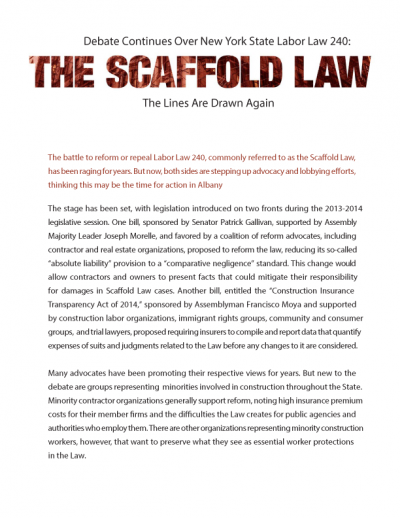
THE SCAFFOLD LAW
WHAT IS LABOR LAW 240?
New York State Labor Law 240, enacted in 1885, requires the provision of scaffolding and other safety devices by all contractors and owners and their agents directing "the erection, demolition, repairing, altering, painting, cleaning, or pointing of a building or structure" so as to give proper protection to workers. The Law has remained static through the decades, despite the creation of the Federal Occupational Safety and Health Administration (OSHA), which has its own detailed regulations on scaffolding, and the dissolution of similar laws in virtually every other state.
While the statute seems inarguably wise, interpretation and application of the Law have been the subject of contentious debate. According to reform advocates, in practice the Law assigns absolute liability for worker injuries to the contractors and owners directing such work and does not allow for consideration of a worker's contribution to his or her injuries. Ted Xenakis, Director of Claims for Lend Lease (US) Construction LMB Inc., said in his twenty years handling such cases, "[The] recalcitrant worker defense in Labor Law cases are few and far between."
Countering the claim that contractors have "absolute liability" and no ability to argue worker negligence in Scaffold Law cases are the Law's supporters, including the Building and Construction Trades Council of Greater New York (BCTC). BCTC President Gary LaBarbera maintains that the Law can only be applied if the contractor has failed to provide proper safety equipment. He adds that if the contractor fulfills their legal obligation to do so, and a worker ignores those safety measures, that worker is not entitled to damages.
Reformers say this is true in theory, but risk managers and defendant attorneys note that, in practice, defense of owners and contractors in these cases is virtually impossible and most are settled out of court to avoid what Mr. Upshaw called the "wild card" of jury awards. Contractors pay high premiums, legal fees, and settlements to the plaintiff, he said, adding, "You pay, and you pay again."
Recent court decisions have broadened the application of the Scaffold Law even further to include: all injuries resulting from the force of gravity rather than falls from height (Runner v. New York Stock Exchange, 2009); injuries related to "same-level" falling objects (Wilinski v. 334 East 92nd Housing Development Fund, 2011); and injuries caused by worker negligence (Kiln v. State of New York, 2013).
These precedents have created conditions enabling a perfect storm of higher jury awarded damages for plaintiffs, higher payouts for insurance companies, and higher premiums for contractors and owners.



